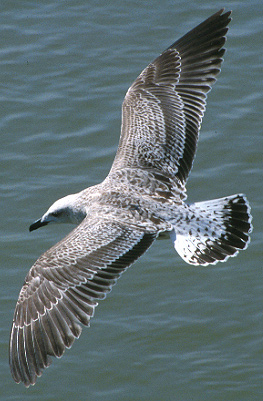 Yellow-legged
Gull - Larus michahellis
Yellow-legged
Gull - Larus michahellis
(last update: October 08 2013)
Coordinators:
Delfín González
Gabriel Martín
Antonio Gutierrez
Amir Ben Dov
Mars Muusse
Yellow-legged Gull michahellis 1CY August 24 2000, Etaples, NW France.
For identification of 1CY Yellow-legged gull in
flight it's best to concentrate on :
- the absence of a clear 'window' (as in
Herring Gull argentatus and to a lesser extend in Pontic Gull cachinnans)
in the inner hand;
- the
wedge-shaped tail-band that contrasts with the white rump and upper tail coverts
(on average smallest tail-band of 1CY West European large white-headed gulls).
Clearly, this is a broad-winged gull, with a relatively dark inner hand, although
the inner webs are slightly paler and some paler spots are visible on both webs.
Hence, the wing is not as intense dark as in 1CY Lesser Black-backed Gulls (LBBG, graellsii).
The tail-band is broad in the centre and gradually smaller at the outer
rectrices. Black markings can be found at the demarcation line of the rectrices
and the upper-tail coverts are coarsely marked on a white base.
As in many YLG's in August, a considerable part of the scapulars has already been
moulted to 2nd generation feathers, while the median and lesser
coverts are in active moult.
Note also the heavy black bill and pale head.
This combination only fits YLG and excludes Herring Gull (with, at least, a
paler window at the inner primaries and a broad tail-band) as well as LBBG (with
amongst others, a broad tail-band and all-dark inner primaries). The latter
species has on average a narrower wing with a more pointed hand and normally doesn't show
such an advanced moult stage of coverts. The amount of black on
the tail of the gull in the picture doesn't necessarily excludes LBBG, but more
commonly, LBBG's show finer 'freckling' on the tail-base instead of the coarse
markings as in this bird.
